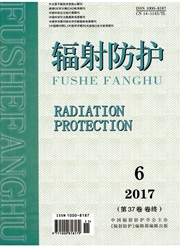

 中文摘要:
中文摘要:
针对内陆核电选址中小风、静风频率较高的厂址,分别采用美国核管会(NRC)导则推荐方法和运用三维客观诊断风场与Lagrangian烟团模型模拟整年8760/b时逐时排放方法,计算了湖南桃花江厂址事故工况下的大气扩散因子,探讨复杂条件下大气扩散模型的适宜性。研究表明:在非居住区边界概率论方法计算的最大小时事故扩散因子较烟团模型计算方法保守;Lagrangian烟团模型计算的小时事故扩散因子在某些方位大于概率论方法结果,某些远距离子区的扩散因子大于近距离子区;对于释放时间相对较长的情形,导则方法估算结果仍偏小。由此可见,导则推荐方法得到的扩散因子存在不保守的情形,建议在计算复杂地形、小静风频率较高的内陆厂址事故扩散因子时慎重选择扩散模型。
 英文摘要:
英文摘要:
The applicability of atmospheric diffusion models in complex terrains and low wind speed conditions was discussed in this paper. The accident atmospheric dispersion factors (ATFs) of Taohuajiang nuclear power plant were calculated by using two methods: the probabilistic method recommended by the U.S. Nuclear Regulatory Commission (NRC) and the three dimensional objective diagnostic wind field model coupled with Lagrangian trajectory puff model to simulate the 8 760 hourly emissions of radioactive nuclides. The results indicate that the maximum hourly accident ATFs calculated by the probabilistic method are conservative in exclusion area boundary (EAB) . However, in some directions, accident ATFs calculated using probabilistic method is smaller than that using Lagrangian puff model, as well as some accident ATFs in remote sectors are larger than those in close sectors. Moreover, results calculated by probabilistic method are smaller in long-term release situation. Therefore, accident ATFs obtained according to the regulatory guides may not conservative in some cases, and atmospheric diffusion model should be selected carefully when a nuclear plant is located at a site with complex environmental conditions.
 同期刊论文项目
同期刊论文项目
 同项目期刊论文
同项目期刊论文
 期刊信息
期刊信息
